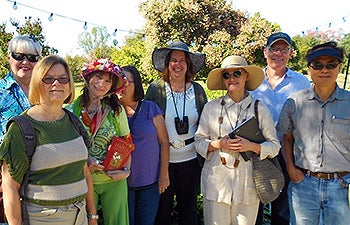The Art of Haiku
Haiku poet Deborah P. Kolodji was recently caught in dense traffic on the 10 Freeway. Looking up, a V-formation of birds flew overhead. Nearby, an airplane cut across the sky. Things were in motion.
She saw poetry:
migrating birds
the line of planes
at rush hour
Kolodji, who earned her bachelor’s in mathematics from USC Dornsife in 1981, keeps a notebook tucked in her purse to capture these moments of inspiration. She fills them up quickly.
“Haiku helps you take little mental snapshots of your world,” Kolodji said. “It also makes you more observant.”
Kolodji has published more than 800 poems in poetry journals and online magazines, and previously served as president of the Science Fiction Poetry Association. To date, she has published four chapbooks of poetry. In addition to haiku, she writes longer poetry, memoir and short stories.
She’s apt to tweet out her haiku. Her Twitter page is a feed of sparse and evocative images.
May 3, 2014, she posted:
the woolly leaves
of pearly everlasting…
she says “it’s complicated”
Typically a three-line imagistic poem of 17 syllables or fewer, haiku tend to focus on nature. Traditional forms of haiku create associations between two images and use a “season word,” or kigo, to anchor the poem in a specific time of year.
For instance, Kolodji’s poem from the July 2002 issue of World Haiku Review embodies those principles, juxtaposing the vibrant blossoms of spring with a grandmother’s craft:
thistles in bloom
grandmother’s needle threaded
with purple
The art is in creating a haiku that, like a Japanese ink wash painting, conveys its subject in a few simple brushstrokes. People bring their own life experiences to the poem, and the magic is in the push and pull between what is presented by the poet, and what is absorbed by the reader.
“A good haiku is universal,” Kolodji said. “That’s what I love about haiku. I write about moments that speak to me, and hopefully they speak to other people.”

Kolodji (center) leads a ginko, or haiku walk, at the Los Angeles County Arboretum and Botanic Garden for members of the Southern California Haiku Study Group. Photo courtesy Deborah Kolodji.
Kolodji helps others immerse themselves in the art of haiku as moderator of the Southern California Haiku Study Group. The group meets on the third Saturday of the month at the USC Pacific Asia Museum.
Founded in 1971, the museum is located in a 1924 Chinese Qing Dynasty-inspired mansion in downtown Pasadena. Its collection of more than 17,000 items from across Asia and the Pacific Islands spans more than 5,000 years.
In November 2013, the museum and USC announced a partnership that enhances the scholarship of USC creative faculty and students and provides a foundation for a museum studies and curatorial training program at the university.
The haiku study group is free and open to the public. Monthly meetings are devoted to studying, writing and sharing haiku.
On occasion, Kolodji will lead the group in ginkos, or haiku walks. They visit locations throughout Southern California, such as the Los Angeles County Arboretum and Botanic Garden in Arcadia; The Huntington Library, Art Collections and Botanical Gardens in San Marino; and the Bolsa Chica Ecological Reserve in Huntington Beach.
“Walking around in nature is a perfect inspiration for writing haiku,” Kolodji said.
The group also participates in local events dedicated to haiku. In 2013, the study group co-hosted the bi-annual conference for Haiku North America, the largest and oldest gathering of haiku poets in the United States and Canada.
Leading up to the event, they ran a booth devoted to haiku at the 2013 Los Angeles Times Festival of Books held at USC’s University Park campus. Visitors could purchase books of poetry, and create haiku with the help of seasoned poets.
This past year, Kolodji led an introductory haiku workshop at the book festival for Kaya Press, a nonprofit publisher of Asian and Pacific Islander diasporic literature, housed in USC Dornsife’s Department of American Studies and Ethnicity.
The event provided Kolodji with the opportunity to share her passion with a broader audience, and to spend time on campus, which she calls “her happy place.”
Kolodji, who is currently a senior technical consultant for a business software firm, looks back fondly on her time at USC Dornsife.
As an undergraduate, she had a passion for science and technology, all the while writing poetry. She chose a subject in letters, arts and sciences over specializing in computer science so she could simultaneously pursue her interests in the humanities through her general education course requirements.
“I took electrical engineering courses, but a math degree allowed me to humor the part of me that really wanted to take G.E. classes in mythology and English literature,” she said.
Kolodji said she benefited greatly from the breadth and depth of her liberal arts education.
“I always feel that USC was a really important part of transitioning me into a wider world,” she said.
She continues to capture that world one snapshot at a time. One recent afternoon she noticed a group of high-school athletes in their sports gear leaving a popular Southern California burger joint. The local bird life cawed in the distance. She tweeted:
wild parrots
the team orders 4x4s
from In-and-Out